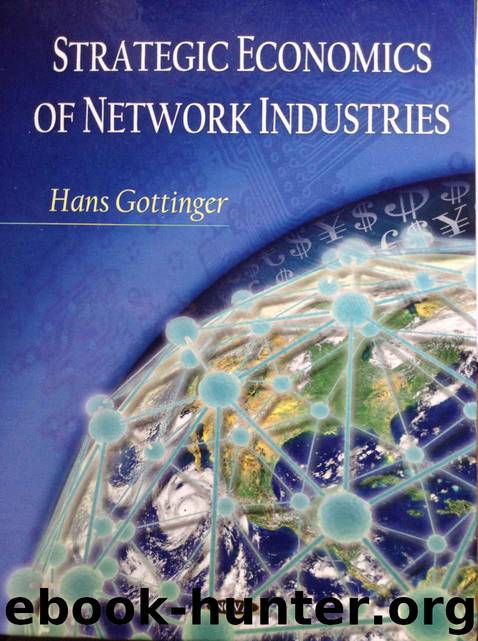Strategic Economics of Network Industries by Gottinger Hans

Author:Gottinger, Hans
Language: eng
Format: epub
Publisher: Nova Science Publishers, New York
Published: 2015-05-18T16:00:00+00:00
5.3. A SI M P L E M O D E L
We assume an economy with two firms, each one producing a differentiated good. There are two firms, h and w. Their initial technologies are represented by constant marginal production costs sh and sw. The first period innovation provides the cost-cutting technology s1. If allowed, the second period innovation offers the cost-cutting technology s. Here, technological progress is limited to be the cost-cutting technology, so called the process innovation. The firm that acquires new technology s1 or s can use it exclusively and produces its output at the cost of s1 or s, respectively. It is assumed, without loss of generality, that sh>sw>s1>s. At the beginning of each period, they compete for new technology s1 or s. Their competition for new technology is like a simple auction in which each firm proposes a bid which represents the maximum amount that firm will pay for the patent of the new technology and the highest bidder wins it. The winner pays -- as expense for buying the new technology --the maximum that the other firm would have paid in order to have the patent rather than not to have it. The loser does not owe anything.
The product market is specified by a differentiated duopoly of the Dixit (1979) type with linearity in demands assumed as follows:
qh = a % bph+cpw
qw = a % bpw+cph
where qi represents the demand for firm i and pi its price. It is further assumed that
a R 0 , b R c L 0 (1)
and
qh = a % bsh + cs L 0 (2) The goods are independent when c=0, while they are substitutes when c>0. When b=c, the goods are perfect substitutes. The assumption (2) implies that both firms are guaranteed to be active even after innovation.
After the race for new technology s1 or s, the firms compete in product market where the Bertrand competition is assumed. They set prices and the non-cooperative Nash equilibrium concept is adopted as the equilibrium in the product market.
Download
This site does not store any files on its server. We only index and link to content provided by other sites. Please contact the content providers to delete copyright contents if any and email us, we'll remove relevant links or contents immediately.
International Integration of the Brazilian Economy by Elias C. Grivoyannis(98412)
The Radium Girls by Kate Moore(11967)
Turbulence by E. J. Noyes(7977)
Nudge - Improving Decisions about Health, Wealth, and Happiness by Thaler Sunstein(7655)
The Black Swan by Nassim Nicholas Taleb(7054)
Rich Dad Poor Dad by Robert T. Kiyosaki(6506)
Pioneering Portfolio Management by David F. Swensen(6253)
Man-made Catastrophes and Risk Information Concealment by Dmitry Chernov & Didier Sornette(5951)
Zero to One by Peter Thiel(5729)
Secrecy World by Jake Bernstein(4698)
Millionaire: The Philanderer, Gambler, and Duelist Who Invented Modern Finance by Janet Gleeson(4417)
The Age of Surveillance Capitalism by Shoshana Zuboff(4243)
Skin in the Game by Nassim Nicholas Taleb(4200)
Bullshit Jobs by David Graeber(4136)
The Money Culture by Michael Lewis(4127)
Skin in the Game: Hidden Asymmetries in Daily Life by Nassim Nicholas Taleb(3960)
The Dhandho Investor by Mohnish Pabrai(3721)
The Wisdom of Finance by Mihir Desai(3691)
Blockchain Basics by Daniel Drescher(3535)
